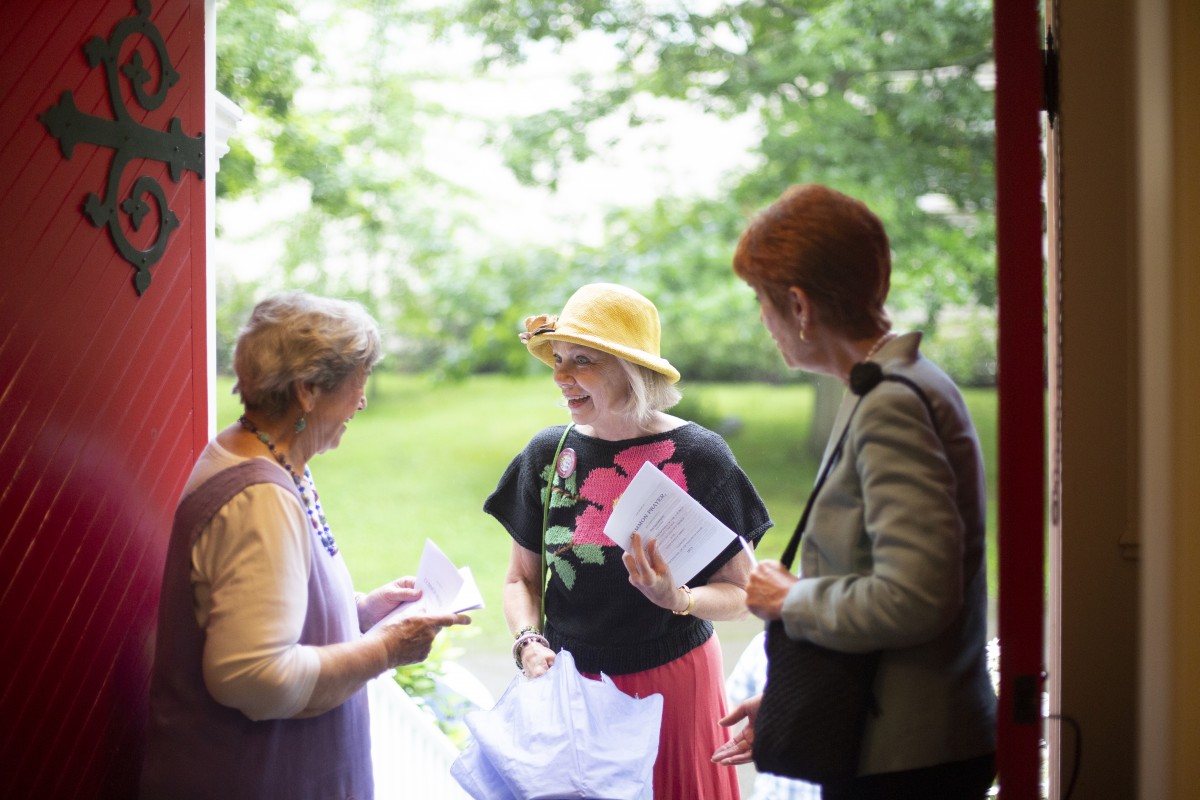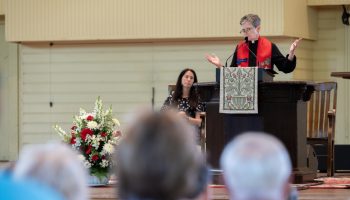In the little white and red chapel near Thunder Bridge, time reversed to 1894 — for about an hour last Sunday.
It was one of those peaceful, gray and drizzly mornings. Parishioners filed into the Episcopal Chapel of the Good Shepherd to celebrate its 125th year with a service that would have been similarly performed at the time of the building’s dedication.
With its doors closed most of the year, the chapel has served Chautauquans during the summer season for 125 years. Nestled in a cozy spot across from the Hall of Christ, the chapel is now a bright and pristine building, thanks to renovations in the 1990s, and again in 2015, to preserve it. The chapel is one of only two free-standing churches on the grounds.
“The greatest thing in terms of being able to celebrate 125 years is it is still here, and it is now in excellent condition and can hopefully endure for another 100 years,” said the Rev. Virginia Carr, who serves as the vicar of the chapel and the reverend at St. Peter’s Episcopal Church in Westfield.
A Late 1800s Service
Past and present came together last Sunday during the chapel’s celebratory service.
The Rt. Rev. Eugene Taylor Sutton, bishop of the Episcopal Diocese of Maryland, led the service, reading out of the 1886 Book of Common Prayer.
At points, Sutton’s Sunday service resembled a stand-up routine, with jokes peppered throughout.
“For our latecomers and any who may still be at the door coming, this being an Episcopal chapel, undoubtedly, there are seats up front,” he said. “Why do Episcopalians fill up from the rear? Because there are no spaces left in the parking lot.”
The Rev. David Meyers served as the clerk of the service. In historical services, there were no bulletins for parishioners to follow along with the service. Instead, they would look to the clerk. When he spoke, they knew they were also supposed to speak. Sutton played off that idea at the beginning of his sermon.
“When he laughs, you are to laugh,” he said. “When he cries and weeps, you are to weep.”
Carr suggested that the chapel celebrate its 125th year with a historical service that would have been performed at the time of its dedication in 1894. The Episcopal service remained largely the same from 1662 to 1978, with slight changes in 1928.
“The essence of (the service) is very similar,” she said. “What is different is that the parts are arranged differently. The ‘Gloria’ that is sung at the end of the old service is now sung at the beginning of the service. We have far more music now than they did then.”
Additionally, Episcopal churches were decorated more simply than they are now.
“There were no candles, no adornments,” Carr said. “It was very plain and very simple.”
On Sunday, Sutton sat at the end of the altar to emulate how in the 1800s, the priest celebrated from the end of the table. During modern services, priests speak from the middle of the altar. He and Meyers wore plain, black and white vestments.
As a finishing touch, Chautauquans Angela James and Kim Meyers collected white and sky-blue flowers from their gardens to fill the vases on either side of the chancel, just as the original parishioners likely did. Nowadays, the chapel’s flowers get delivered by a florist in Westfield.
125 Years of History
Before the chapel was dedicated in July 1894, Episcopals at the Chautauqua Assembly met to worship in a tent where the Arts Quad is today, according to a booklet on the chapel’s 125-year history written by Daily staff writer and local historian, Mary Lee Talbot, and commissioned by the chapel for the anniversary. (Those interested in purchasing a copy of the book may email
chqchapelbooklet@gmail.com.)
The Chautauqua Assembly offered a free 40-by-50 foot plot of land to each religious denomination. The Episcopals felt the plot was too small, so they rented two adjacent lots to build the church on. The church was built and furnished for $1,726, Talbot wrote.
The June 23, 1894, edition of The Living Church, an Episcopal Church newsletter, described the new place of worship:
“The chapel will be in pleasing contrast with the majority of buildings at Chautauqua, being of the English rural chapel type, with long, sloping roofs of soft, mossy-brown shingles, projecting cowl with half-hidden bell and a gabled facade.”
St. Alban’s Episcopal Church in Silver Creek, New York, which was built in 1892, has an identical design.
According to Talbot, the chapel was the center of Episcopal life at the Institution for years. The first Episcopal cottage, the current site of the Christian Science House, was not purchased until 1919. In 1955, the cottage moved to its current location on the brick walk at the corner of Peck Avenue.
The chapel started out under the care of St. Paul’s Episcopal Church in Mayville, Talbot wrote. It entered the purview of the bishop of the Diocese of Western New York in 1987.
At first, according to Talbot, services were only held on Wednesdays and Fridays. Now, they are held at 7:45 a.m. on weekdays, and 7:45 a.m. and 9 a.m. on Sundays. Carr leads a Compline at 9:30 p.m. on Sundays. Bible study is held at the Episcopal Cottage after the Wednesday morning services.
Weekday Catholic masses occur in the chapel at 8:45 a.m. and 12:10 p.m.
The 100th year in 1994 was celebrated with renovations of the chapel’s foundation, work on some of the stained-glass windows and the addition of eight new windows, each honoring an important religious or cultural figure, on the side walls of the chapel.
The windows honor people such as Pope John XXIII; Lewis Miller, co-founder of Chautauqua Institution; Florence Nightingale, founder of modern nursing; and Archbishop Desmond Tutu, who worked as an anti-apartheid advocate in South Africa.
The 1994 renovations were crucial to the long-term success of the chapel, Carr said.
“The chapel itself, the building, in the mid-1990s was in great disrepair,” she said. “It was falling apart.”
In its 100th year, chapel members created a list of physical projects to accomplish, Carr said.
This included a revamping of the interior of the chapel, which was completed in 2015. James, a member of the chapel’s board, said the crew removed an ugly raspberry-red carpet to reveal the original pine flooring below the altar.
The ceiling was the same shade of red, James said. Now, it is white above the pews and blue above the altar, to signify the difference between Earth and heaven.
The pews were removed and repaired by an Amish craftsperson in Pennsylvania, to restore them after decades of use.
Carr said the last project from the 1994 list, a renovation of the sacristy — a room in the back right corner of the building used for storage and to prepare for the service — was just completed this past spring.
James and her husband, William James, who are both on the board of the chapel, led a project to install a columbarium in an underutilized space behind the organ. Dedicated in 2008, it is now the only place on the grounds where ashes can be interred.
Each niche costs $4,000. The money raised from the columbarium serves as the chapel’s entire endowment.
The James family has purchased four of the columbarium’s niches — one for Angela and William, and the others for their three children.
Nine people’s remains are currently in the columbarium, including those of Ron Hermance, which were interred last Saturday. As the first chairman of the chapel’s board, Hermance helped to finance the structural repairs of the chapel in the 1990s.
The ability for people to use the chapel as their final resting place is a continuation of its legacy and its mark on local history.
“It’s just a place of welcome and peace, and beauty and prayer, and for me, fellowship,” James said.
Very Much Alive
In a place so steeped in history, the gardens that surround three sides of the chapel provide a reminder that the chapel is still very much alive.
The flowers in the garden beds are exclusively red and white to match the colors of the chapel. The white comes from flowers like daisies and oakleaf hydrangea; the red from bee balm, cardinal flower and Lucifer flower.
At the Sunday service, a vase of Lucifer flowers rested on the top of the steps right outside the front door. No one would dare to bring the flowers, named for the devil, inside.
“We have adopted the idea that we’re trying to move toward native shrubs and perennials,” James said, as she readied the chapel July 25 for its morning service the next day.
James also serves as the president of the Chautauqua Bird, Tree & Garden Club, which advocates for environmentally friendly gardening practices through lectures and other programming.
The exterior plants are the first indication of the activity within the building. With eight Episcopal services and 10 Catholic masses each week, the chapel is frequently in use during the summer season.
The Episcopal services are run by a different chaplain each week. They apply and are selected by Carr.
“I look for a diversity of clergy so they’re not all from the same area or theologically the same,” she said. “Even within the Episcopal church, we have diversity. I have chaplains from all over the world who come.”
Sutton, the Week Six Episcopal chaplain, is the first African American bishop for the Diocese of Maryland. He has been to Chautauqua as chaplain-in-residence before, and on Aug. 21, he will give the 2 p.m. interfaith lecture in the Hall of Philosophy.
With about 60 to 80 people attending its Sunday services each week during the summer, the chapel is very much alive and well, 125 years later.
“There are services here; I had a burial on Saturday; I have done weddings here; we have baptized babies,” Carr said. “It is not just a building, but it is alive.”






